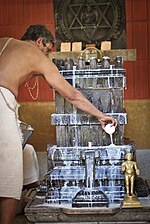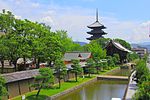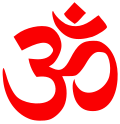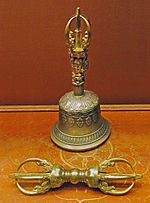of several Emperors, Kūkai was able to preach Shingon teachings and found Shingon temples. Like other influential monks, Kūkai oversaw public works and...
35 KB (4,462 words) - 15:03, 19 June 2024
Shingon Buddhism (category Kūkai)
named Kūkai (空海, 774–835), who traveled to Tang China and received these esoteric transmissions from a Chinese master named Huiguo (746–805). Kūkai established...
92 KB (11,510 words) - 01:36, 24 May 2024
Saichō (section Relationship with Kūkai)
from Kūkai, but despite Kūkai's repeated requests he did not return to Takaosan-ji to resume his studies. Their rapport finally terminated when Kūkai harshly...
23 KB (3,131 words) - 02:58, 5 December 2023
a multi-site pilgrimage of 88 temples associated with the Buddhist monk Kūkai (Kōbō Daishi) on the island of Shikoku, Japan. A popular and distinctive...
37 KB (1,581 words) - 08:39, 30 June 2024
lineage of Vajrayana transmitted to Japan, primarily in the early Heian by Kūkai, and to a later extent by Saichō and his successors such as Ennin. It consists...
14 KB (1,768 words) - 04:15, 22 June 2024
Kukai and the Construction of Esoteric Buddhist Discourse. Columbia University Press. ISBN 0-231-11286-6. PDF online Hakeda, Yoshito S. (1972). Kūkai...
6 KB (559 words) - 20:40, 20 February 2024
(1999). The Weaving of Mantra: Kūkai and the Construction of Esoteric Buddhist Discourse. Hakeda, Yoshito (1972). Kūkai: Major Works, Translated, with...
9 KB (875 words) - 14:04, 14 June 2024
(南岳山). It was founded by Kūkai in 806, making it the oldest Shingon temple on the island of Kyushu. According to tradition, Kūkai or Kobo-daishi set up this...
3 KB (353 words) - 18:37, 21 January 2024
with the qualities of Gautama Buddha, he is able to purify transgressions. Kūkai, the founder of Shingon Buddhism, met a famous monk who is said to have...
10 KB (905 words) - 13:15, 13 June 2024
by the monk Kūkai. Shingon Buddhism emphasizes the use of symbols, rituals, incantations and mandalas, which gave it a wide appeal. Kūkai greatly impressed...
34 KB (4,666 words) - 16:06, 25 June 2024
Tō-ji (category Kūkai)
southwest of Kyōto Station. Tō-ji is often associated with Kōbō Daishi (Kūkai). Though Tō-ji began to decline at the end of the Heian period, it came...
13 KB (1,542 words) - 02:17, 28 June 2024
was transmitted to Japan by Kūkai (774–835), who founded the Japanese Shingon (Japanese for Zhēnyán) mantra vehicle. Kūkai saw a mantra as a manifestation...
93 KB (11,177 words) - 12:17, 8 June 2024
Characters of Xenosaga (redirect from Gaignun Kukai)
Charlemagne and wielder of the legendary blade Durandal, rode into battle on. Kūkai is also the name of a famous Japanese Buddhist monk; Buddhist undertones...
92 KB (14,162 words) - 09:16, 21 May 2024
Japanese Buddhism Japanese Zen Sōtō school Dogen Rinzai school Eisai Shingon Kukai Japanese Confucianism Fujiwara Seika Hayashi Razan Nakae Tōju Itō Jinsai...
40 KB (4,464 words) - 17:10, 13 June 2024
to be introduced in 806 by Kūkai. For both founders to benefit from the introduction of Buddhism, Saichō stood behind Kūkai and helped him get the mountain...
17 KB (2,246 words) - 21:45, 8 March 2024
The Iroha (いろは) is a Japanese poem. Originally the poem was attributed to Kūkai, the founder of Shingon Buddhism, but more modern research has found the...
13 KB (1,295 words) - 10:22, 23 May 2024
Candrakīrti Zhiyi Bodhidharma Huineng Shandao Xuanzang Fazang Amoghavajra Saichō Kūkai Shāntideva Shāntarakshita Wohnyo Mazu Daoyi Jinul Dahui Zonggao Hongzhi...
145 KB (17,105 words) - 01:41, 24 June 2024
(衛門三郎) is a legendary figure of early ninth-century Japan associated with Kūkai and the Shikoku 88 temple pilgrimage. A mendicant visited the house of Emon...
3 KB (308 words) - 21:43, 16 January 2024
in Japan. His book on Kūkai, The Weaving of Mantra: Kūkai and the Construction of Esoteric Buddhist Discourse, underscores Kūkai's impact on 9th-century...
4 KB (313 words) - 06:41, 24 February 2024
the sokushinbutsu ascetic practices of Shugendō were likely inspired by Kūkai, the founder of Shingon Buddhism, who ended his life by reducing and then...
11 KB (1,212 words) - 05:36, 10 June 2024
Candrakīrti Zhiyi Bodhidharma Huineng Shandao Xuanzang Fazang Amoghavajra Saichō Kūkai Shāntideva Shāntarakshita Wohnyo Mazu Daoyi Jinul Dahui Zonggao Hongzhi...
132 KB (15,257 words) - 19:29, 28 June 2024
Legend of the Demon Cat (category Kūkai)
secret to life without sorrow. Huang Xuan as Bai Letian Shōta Sometani as Kūkai Kitty Zhang as Chunqin Qin Hao as Chen Yunqiao Hiroshi Abe as Abe no Nakamaro...
15 KB (1,278 words) - 05:35, 24 March 2024
during his journeys around Shikoku. Kūkai conducted rituals there before going to China. After returning from China, Kūkai visited the site and had the temple...
2 KB (111 words) - 08:38, 30 June 2024
Yoshito S. (1972). Kūkai and His Major Works. Columbia University Press. p. 44. ISBN 0-231-05933-7. Hakeda, Yoshito S. (1972). Kūkai and His Major Works...
4 KB (369 words) - 21:36, 25 November 2023
Candrakīrti Zhiyi Bodhidharma Huineng Shandao Xuanzang Fazang Amoghavajra Saichō Kūkai Shāntideva Shāntarakshita Wohnyo Mazu Daoyi Jinul Dahui Zonggao Hongzhi...
193 KB (22,481 words) - 20:28, 28 June 2024
others. Later Buddhist monks, including Kūkai and Saichō received their ordination here as well. During Kūkai's administration of the Sōgō, additional...
32 KB (3,629 words) - 20:32, 29 June 2024
to be developed in Chinese and Japanese by thinkers such as Yi Xing and Kūkai. Likewise in Tibet, Sakya Pandita (1182–28 – 1251), as well as later thinkers...
97 KB (11,619 words) - 12:49, 26 June 2024
Japanese monks Kūkai, Ennin and Enchin, Korean monks Huiri (惠日) and Wuzhen (悟真) and Indonesian monk Bianhong (辩弘). Especially the Japanese monk Kūkai, who brought...
7 KB (600 words) - 08:07, 4 December 2022
new religions Zen in the US Key figures Shōtoku Tori Busshi Rōben Saichō Kūkai Jōchō Kūya En no Gyōja Hōnen Myōe Shinran Jōkei Eison Ninshō Dōgen Eisai...
119 KB (13,242 words) - 07:07, 28 April 2024
Japanese mythology. According to Japanese Buddhist tradition, the priest Kūkai made Zennyo Ryūō appear in 824 AD during a famous rainmaking contest at...
13 KB (2,023 words) - 03:53, 4 October 2023



























